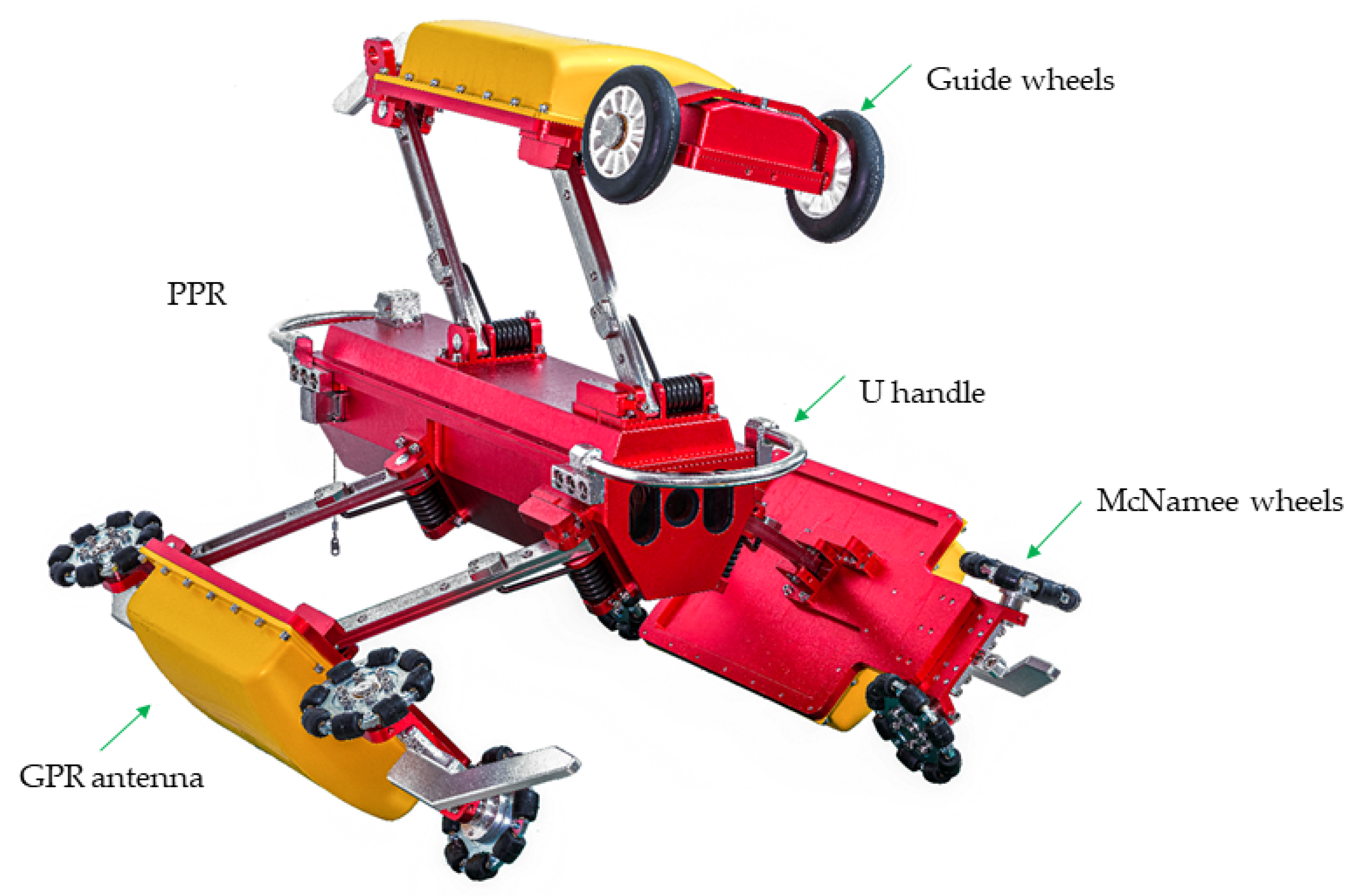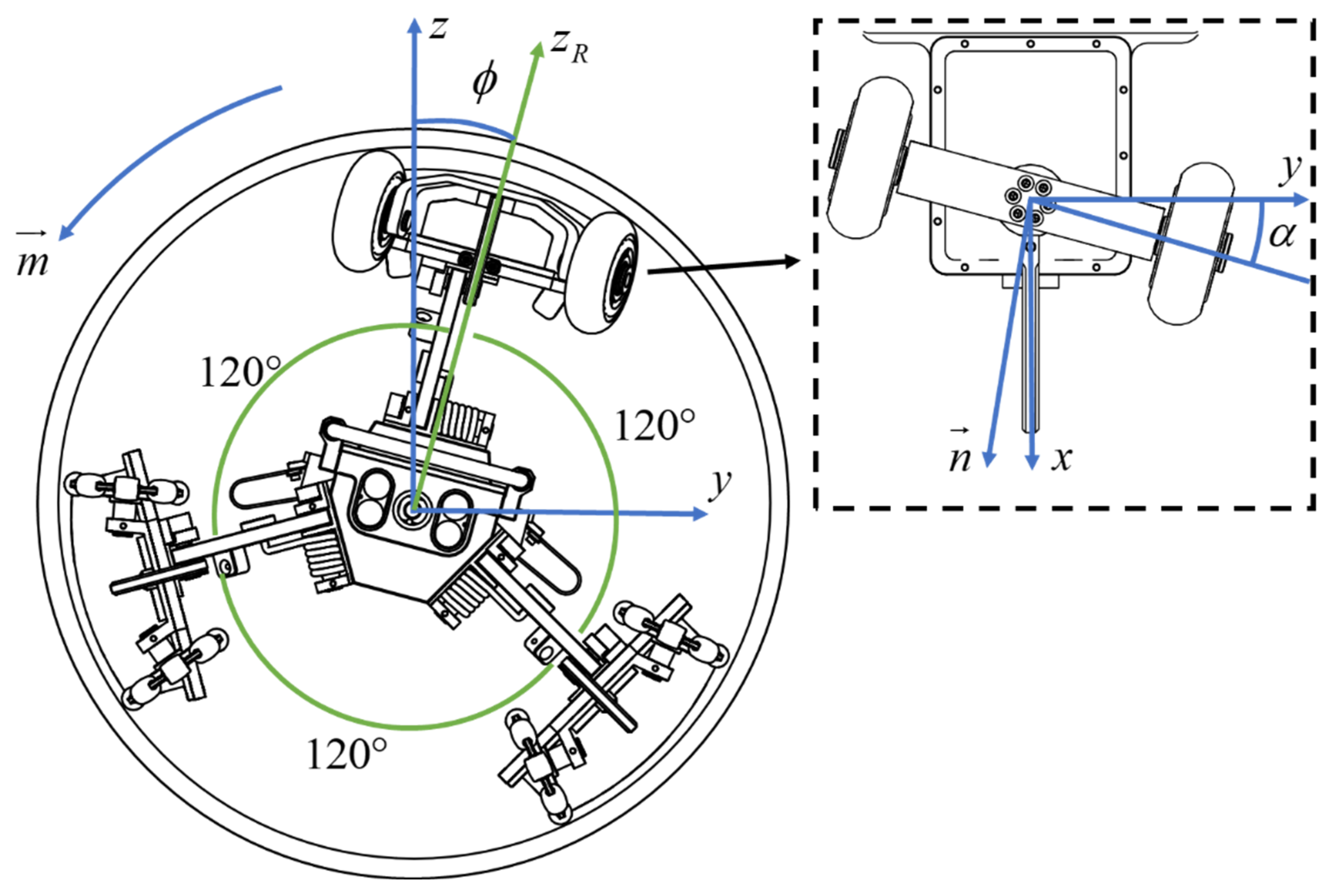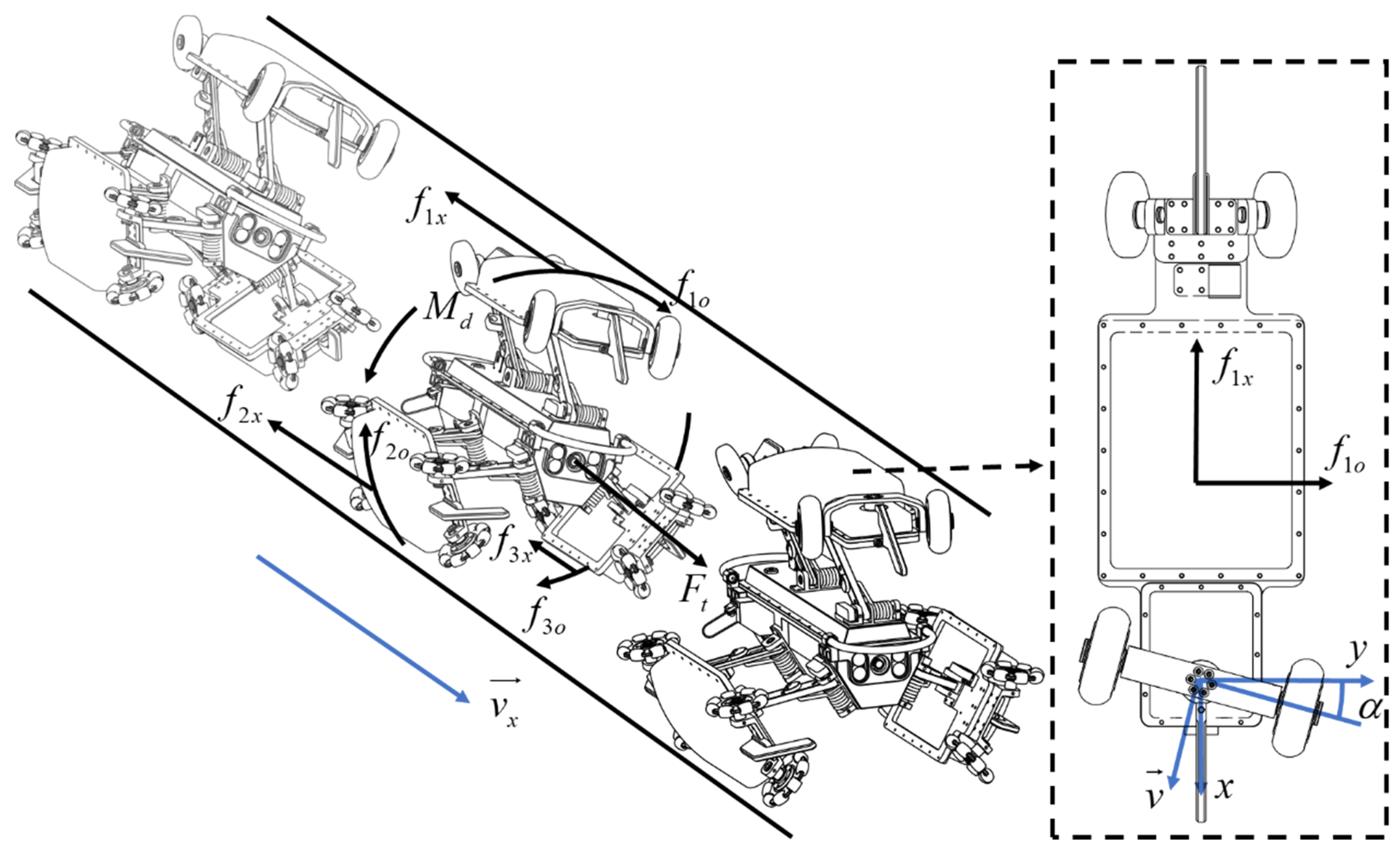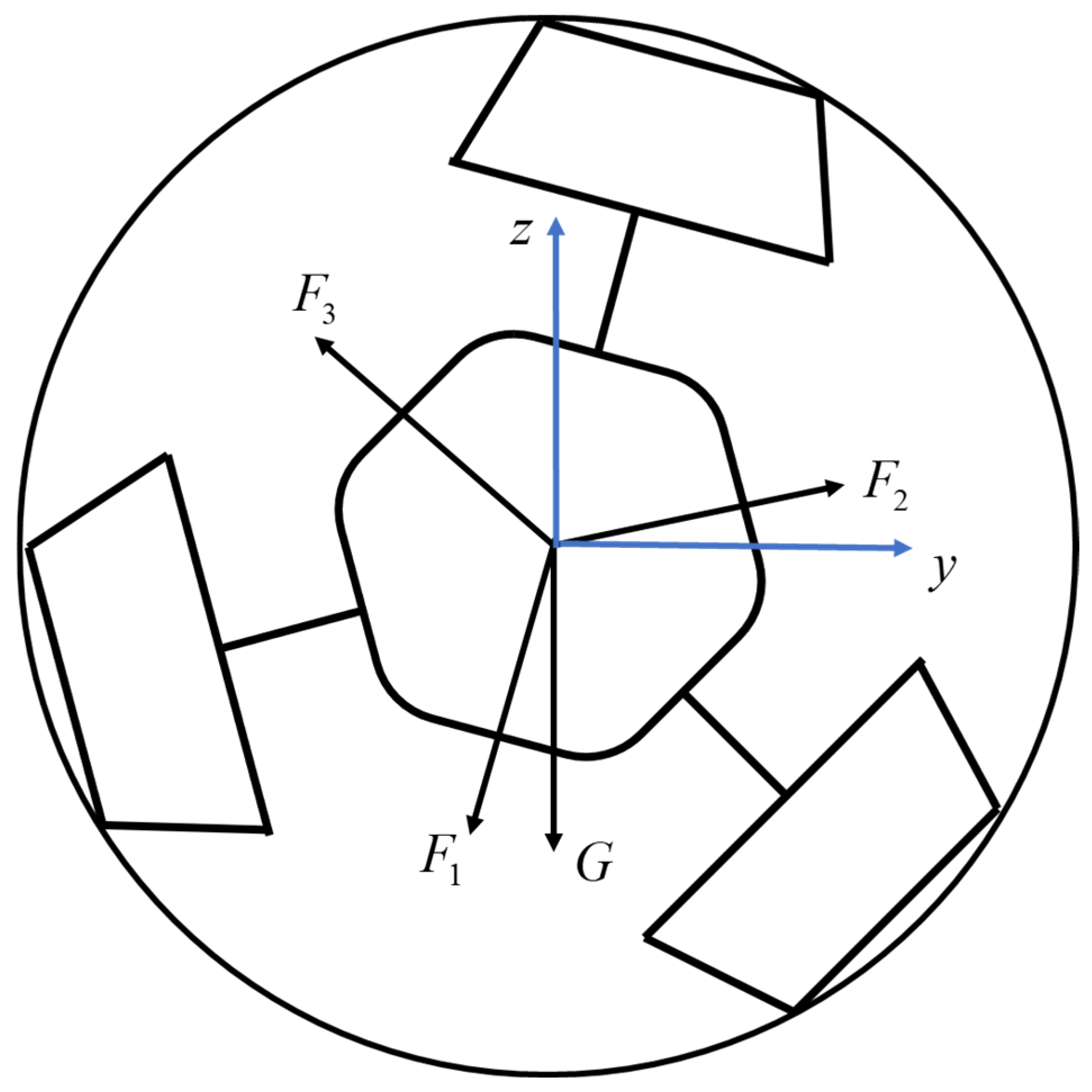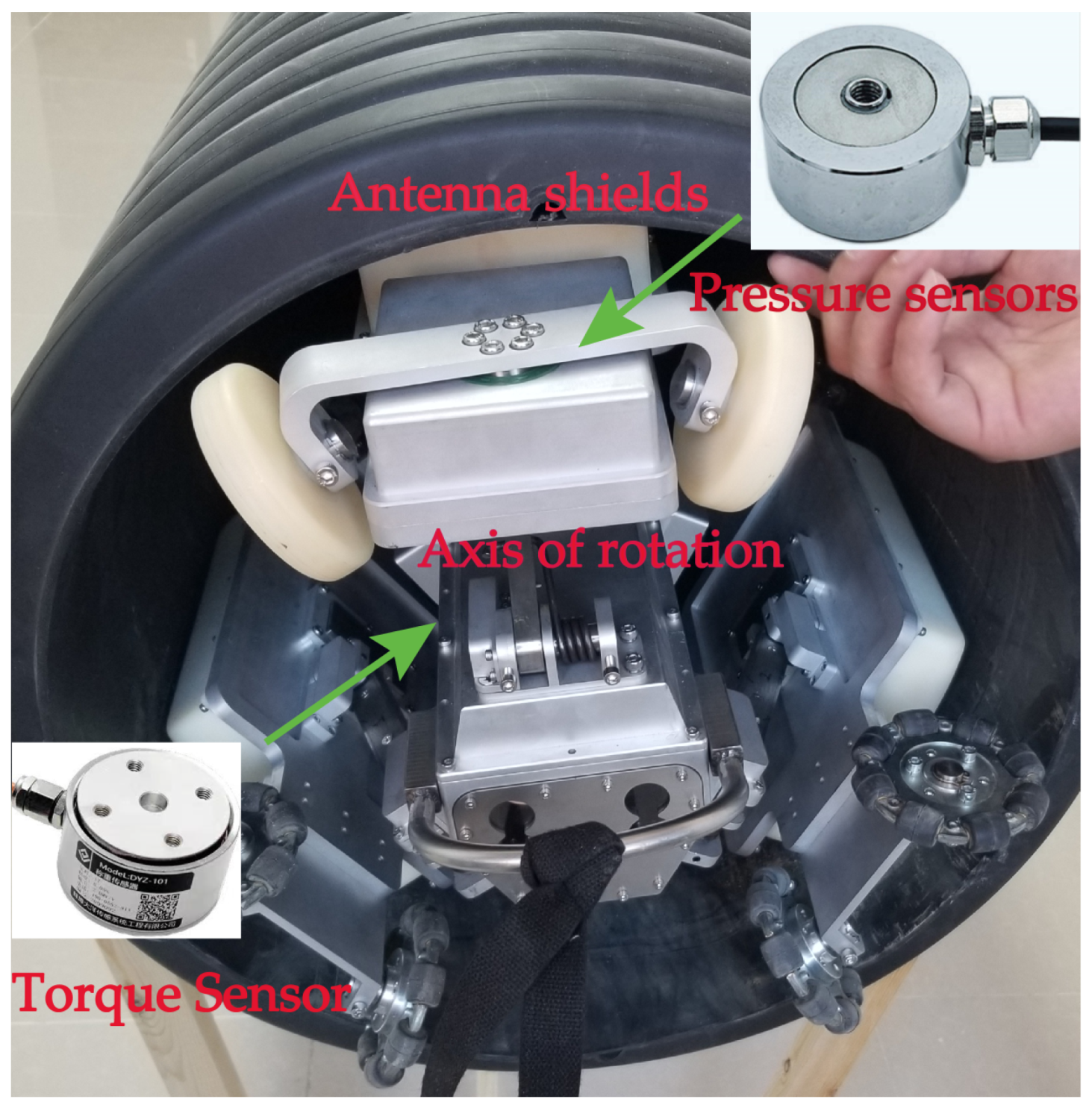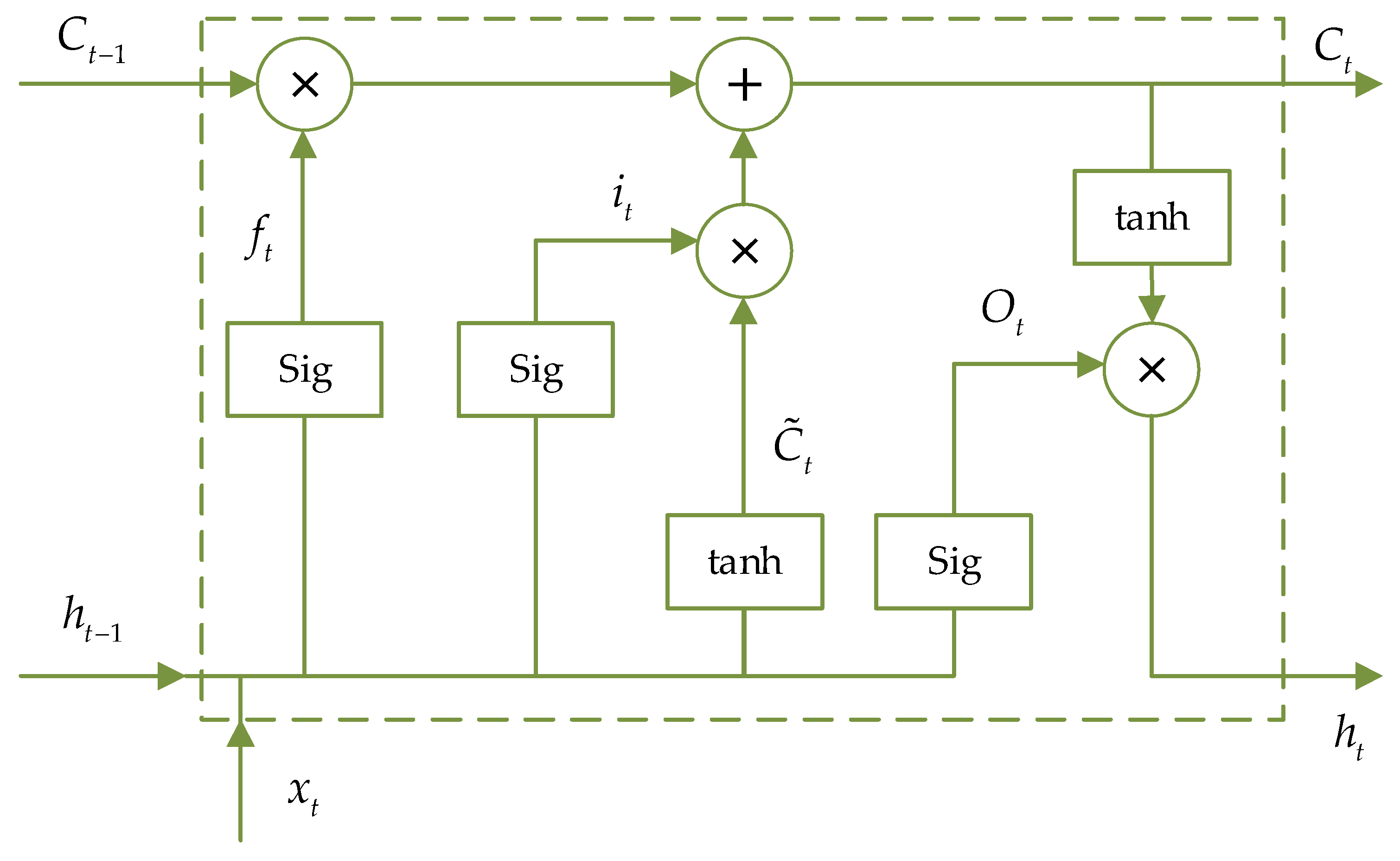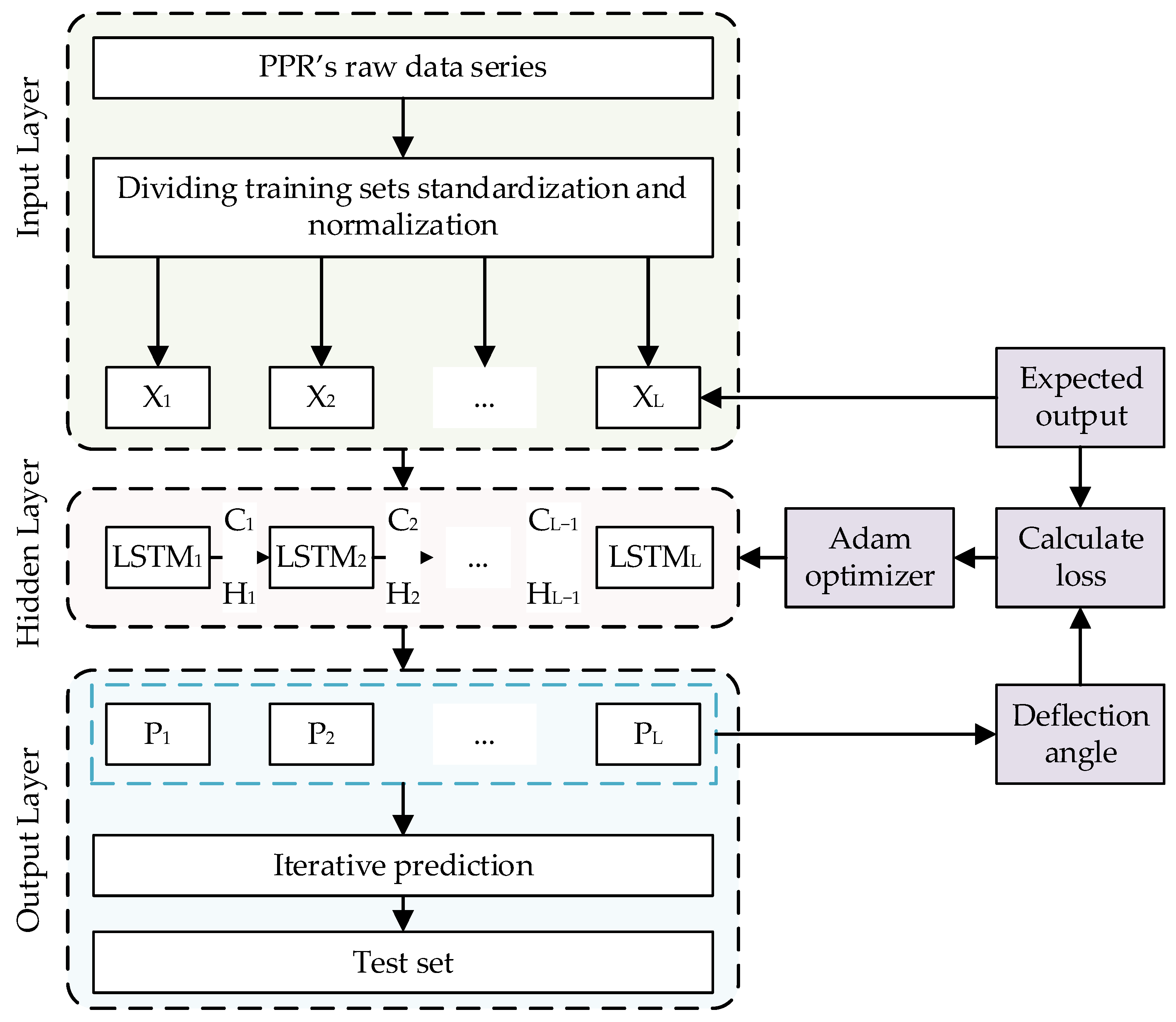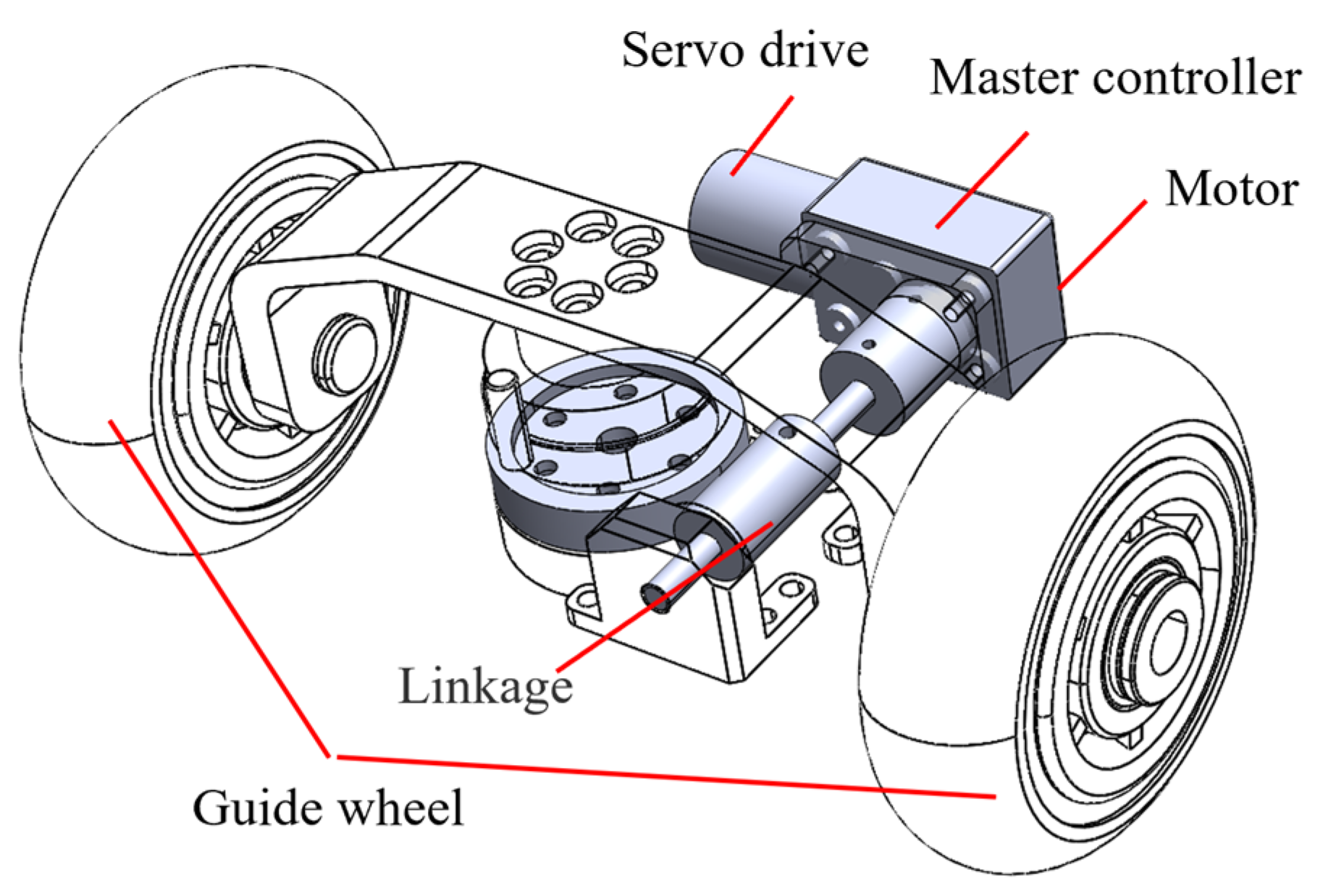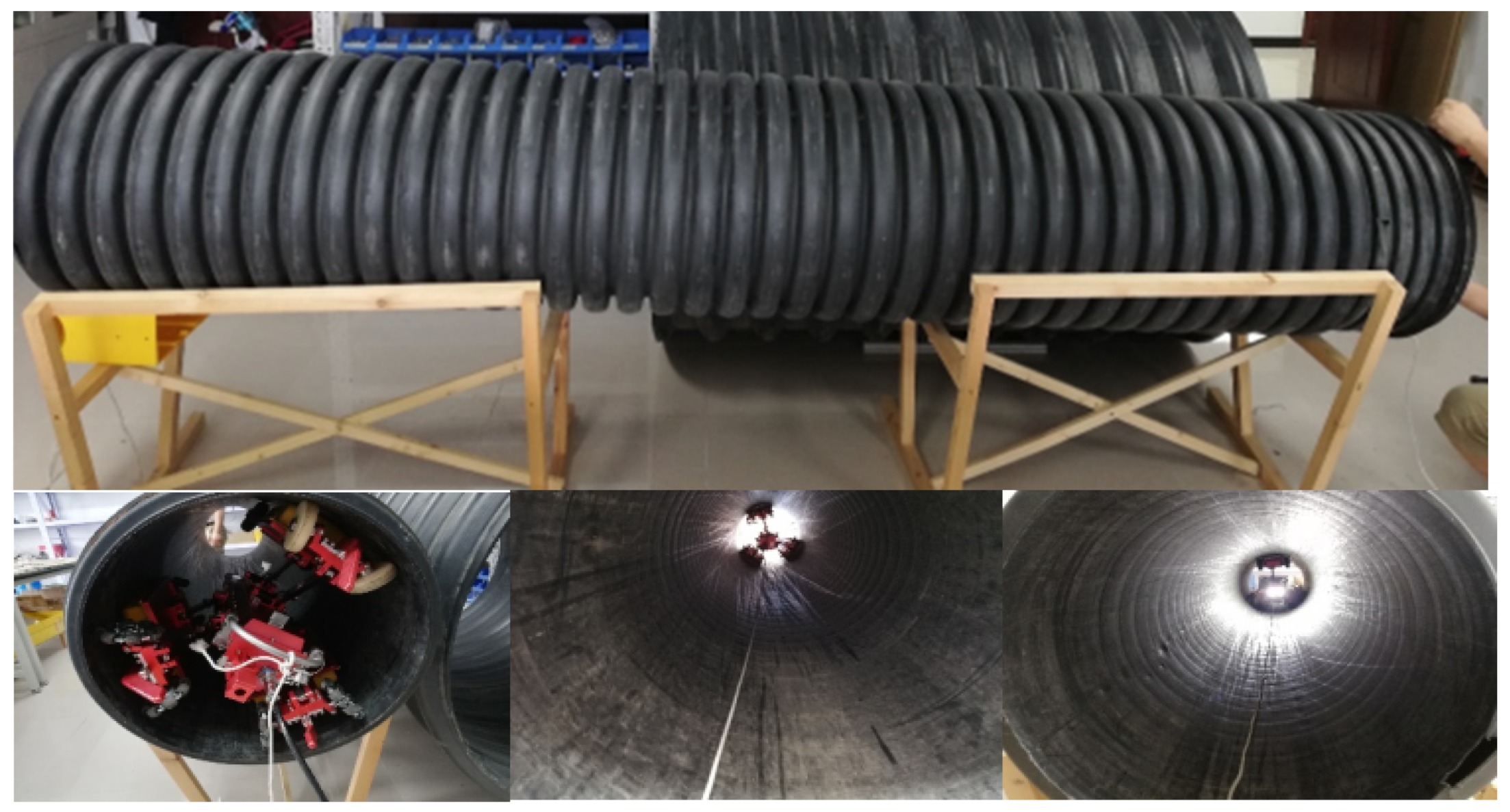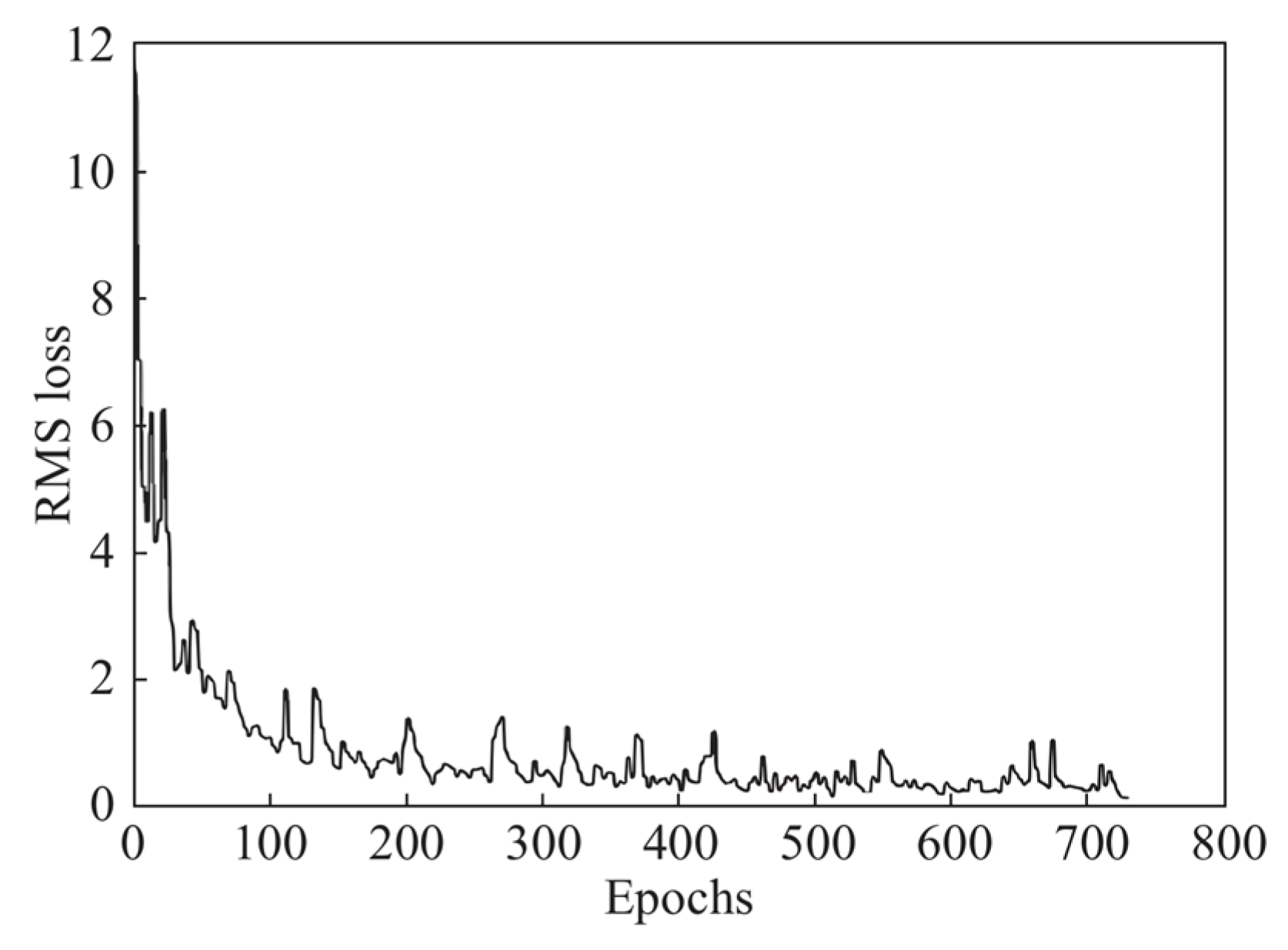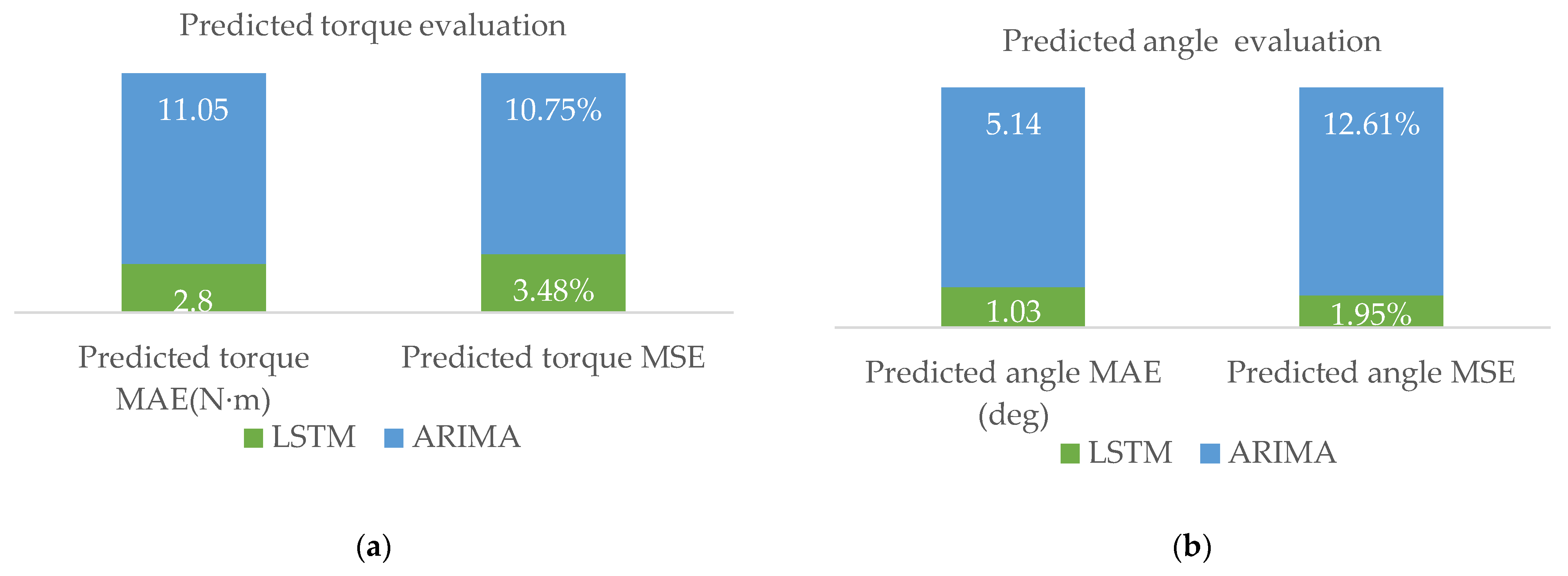1. Introduction
Extensive subterranean drainage systems intersect the urban expanse. In the event of a rupture or leakage within a subterranean drainage pipeline, the ground will give way, resulting in the accumulation of sediment within the pipeline and impeding the flow of urban drainage, thereby gravely compromising the safety of urban operations. Within municipal subterranean pipelines, the drainage pipes are customarily positioned at the base of the substructure. The presence of damaged and leaky drainage pipes contributes to the erosion of neighboring soil, leading to the formation of voids surrounding the pipes, and ultimately instigating the collapse of urban thoroughfares. Thus, the assessment of drainage pipe quality and the identification of voids in their vicinity are of utmost importance in the prevention of urban road collapse.
The pipeline ground-penetrating radar (PPR) detection device is capable of effectively detecting cavities in the vicinity of the pipeline. This capability represents one of the fundamental technologies employed in urban underground space security systems [
1]. The research object of this study is the three-channel drainage pipeline radar detection device [
2,
3], which has been developed by the China University of Mining and Technology (Beijing) and is depicted in
Figure 1. This device consists of a video system and a radar antenna system that are used to determine the corrosion depth of the pipe top and detect voids outside the pipe. Notably, the three channels of the device are positioned at an angle of 120°, enabling simultaneous detection of the pipeline interior, pipe body, and the external environment of the pipeline.
The pipeline GPR is pulled by an electric cable reel at a constant speed to travel inside the drainage pipe. The deviation correction device is located in front of the radar antenna on the top of the PPR. The deviation correction device includes a guide wheel and a servo motor. When the attitude of the PPR deflects, the MCU controls the servo motor to drive the guide wheel to rotate and dynamically correct the attitude angle of the PPR.
The detection of pipeline diseases in engineering employs a traction support wheel for the movement of the PPR, ensuring accurate positioning along the target axis. However, during the actual detection process, the PPR is inevitably influenced by factors such as weight, slope changes, and travel speed, resulting in automatic rotation [
4,
5,
6]. This leads to roll angle deviation, necessitating the correction of the radar antenna angle to accurately locate anomalies in spatial position.
In recent years, scholars and experts have conducted research on PPR attitude control and trajectory planning for correction. For instance, Ren T. et al. compared and analyzed the characteristics of different screw drive in-pipe robots, focusing on mechanism design, driving principles, and motion and mechanical behaviors [
7]. The trajectory correction algorithm of an intelligent tunneling robot system is based on fuzzy proportional-integral-derivative (PID), effectively eliminating lateral errors of the road header for trajectory correction [
8]. Yeh T. et al. designed four control systems to regulate screw speed, lifting torque, steering angle, and overrun angle, enhancing the performance of the robot’s helical motion in pipes with varying inclinations [
9]. However, these methods face challenges in practical applications, including instability, low reproducibility, and the need for extensive training data sets.
The integration of classical control and advancements in deep-learning-based methods has led to the development of new research techniques [
10,
11,
12,
13]. Patel R. et al. effectively combined an adaptive sliding mode controller (ASMC) with recurrent neural networks like LSTM and gated recurrent units (GRU) to develop robust adaptive motion control techniques [
14]. Chen K. et al. proposed a composite control model that combines PID control closed-loop with an LSTM maneuverability model open-loop, improving the dynamic obstacle avoidance ability of robots [
15]. Inoue M. et al. proposed a robot path planning method that combines rapidly exploring random tree (RRT) and LSTM networks, leveraging their high learning and generalization capabilities [
16]. Steuernagel L. et al. suggested the use of an encoder–decoder sequence-to-sequence neural network for complex motions where Kalman predictors cannot account for future robot actions, resulting in better motion planning and decision-making [
17].
The existing support wheel pipeline inspection equipment is pulled along the pipeline via an electric cable reel, and the attitude angle adjustment of the PPR is achieved by adjusting the angle of the guide wheel. However, this operation accuracy is greatly dependent on the operator, leading to a range of issues such as lengthy correction times and over-correction. Consequently, it becomes challenging to ensure the detection and positioning accuracy of the radar antenna. Hence, it is imperative to explore automatic correction control methods for the PPR.
Section 2 describes the rotation characteristics exhibited by the PPR that have been developed internally.
Section 3 offers a demonstration of how the corrective trajectory is generated.
Section 4 presents the prediction of the corrective angle, which is based on the LSTM technique.
Section 5 showcases the experimental results obtained from the self-developed pipeline radar robot. Lastly,
Section 6 draws conclusions for the paper.
2. PPR Rotation Characteristics
The PPR is influenced by various factors while moving inside a pipeline, leading to a gradual change in its initial motion attitude. The three sets of walking mechanisms of the PPR are designed spatially at equal intervals of 120°. To ensure the accuracy of the GPR antennae in locating the defects inside the pipeline, it is necessary to keep the cross-roll angle of the PPR stable. And, it should be corrected when the roll angle changes.
For the PPR to travel in a predetermined attitude, it travels along the central axis without deflection. The spin deflection during its travel must be corrected. The method is to apply an attitude correction moment. The vector of moments pointing in the positive direction of the PPR is specified to be positive. A positive correction moment amplifies the PPR’s roll angle.
2.1. Attitude Angle of the PPR
The definition of the PPR’s attitude angle and the decomposition of attitude deflection force are illustrated in
Figure 2. This figure shows the projection of the PPR’s travel direction in the drainage pipe, with the view angle directly aligned with the radar antenna. The attitude angle (roll angle)
, is defined as the angle between the X–Z plane of the pipeline coordinates and the follower wheel. Counterclockwise rotation is considered positive, while clockwise rotation is considered negative.
In
Figure 2, the
axes constitute a pipeline coordinate system, where the
x-axis aligns with the pipeline axis, and the
z-axis opposes the direction of gravitational force. The
axis corresponds to the direction of the top radar antenna on the PPR.
represents the correction direction in the
plane, the
signifies the forward direction of the PPR.
denotes the angle between the guiding wheel and the pipeline axis, and this angle is utilized to generate the attitude correction angles and torques for the PPR, facilitating its realignment. In this context, the PPR adjusts its attitude correction angles and torques to maintain alignment with the desired direction.
Applying appropriate attitude correction torques to the PPR facilitates the effective adjustment of the radar antenna’s detection angle to meet specific operational requirements. By modulating the magnitude and direction of the attitude correction torque, aligning it with the error in the attitude angle α is achieved.
The process of attitude correction for the guiding wheels of the PPR is depicted in
Figure 3. In the diagram, the details of the correction mechanism are in the dashed arrow and square. The
v represents the speed of the PPR along the pipeline axis. Under the influence of the attitude correction torque
, tangential reactive force
arises between the support wheels of the PPR and the pipeline wall. The traction force experienced by the PPR is denoted as
, and
represents the frictional force acting along the pipeline axis. This calibration process involves motion velocity, attitude correction torque, and interactions with the pipeline wall to achieve precise control of the PPR.
If the support wheels of the PPR are rigid, three potential scenarios may arise:
When the lateral reaction force
does not exceed the lateral attachment limit between the support wheel and the inner wall of the pipe.
where
is the closure force of the support wheel
i,
is the lateral attachment coefficient between the support wheel and the pipe wall,
is the radius of the pipe. There is no lateral sliding between the support wheel and the pipe wall, the support wheel still travels in its flat direction, and the attitude correction torque
is suppressed for the correction of the attitude angle.
When the lateral reaction force
reaches the lateral attachment limit between the support wheel and the inner wall of the pipe.
Then lateral sliding occurs between the support wheel and the pipe wall; the sliding velocity is
, the support wheel then travels in the direction of the synthetic velocity, the attitude correction torque
takes effect on the correction of the attitude angle, and after
moments, the PPR attitude angle changes to:
When the attitude correction torque continues to increase by
, the PPR attitude angle correction equation is
where
is the rotational inertia of the PPR around its central axis. At this time, the PPR changes its attitude angle from the initial position with angular acceleration.
Since the support wheel of the PPR cannot achieve complete rigidity, when the support wheel is elastic in the lateral direction, even if the lateral reaction force
does not reach the limit of lateral attachment between the support wheel and the inner wall of the pipeline, the direction of travel of the support wheel will deviate from the pipeline axis. The angle of deviation
is related to the closure force
on the support wheel and the attitude correction torque
. In the case of a certain closure force
, when the angle of
β is small, the relationship between
and
is linear as follows:
where
is the lateral stiffness of the support wheel in N·m/rad. The larger the lateral stiffness, the smaller the lateral elasticity of the support wheel, and the smaller
β is. Therefore, under the action of attitude correction torque
, the attitude angle formed due to the lateral elasticity of the support wheel is corrected as:
where
is the distance moved by the PPR along the pipeline axis;
is the speed.
In summary, the PPR is analysed by the guiding wheel to generate the attitude correction angle and torque to form a certain angle
α between it and the pipeline axis, as shown in
Figure 3. When the PPR is in the pipeline with a pipeline radius of
R, moving along the pipeline axis, with a speed
v, the guiding wheel makes a mixed motion of sliding and rolling. At this time, the friction force along the lateral component perpendicular to the pipeline axis will generate the attitude correction torque, the expression of which is:
where
is the correction torque coefficient [
18], and
produces the maximum attitude correction torque. By adjusting the size of the angle, the size and direction of the attitude correction torque can be adjusted to correct the PPR’s roll angle.
2.2. PPR Motion Resistance
During the movement of the PPR within drainage pipes, the antenna experiences pressure against the pipeline wall due to the action of torsion spring elasticity. If the guiding wheel is subjected to pressure against the pipeline wall, frictional forces will arise between the guiding wheel and the pipeline wall. If the direction of the frictional force forms an angle with the pipeline axis, it generates the necessary corrective torque for attitude correction. The greater this frictional force, the larger the corrective torque. Due to the influence of gravity, pressure between the left and right sections of the radar and the pipeline wall generates frictional forces that impede the torque required for attitude deviation. This frictional force directly hinders the correction of the PPR. An increase in frictional resistance leads to a reduction in the ability to correct at the same deviation angle, and vice versa. These frictional forces are influenced by pressure. Therefore, the pressure between the radar and the pipeline wall plays a crucial role in the correction process. Pressure provides essential parameters for calculating the deviation trajectory.
The force diagram, as shown in
Figure 4, simplifies the PPR in its movement within the pipeline.
PPR experiences gravitational force
; the three arc-shaped radar antennas receive from the pipeline wall support forces
; the deviation angle of the PPR is
. The equilibrium equation in the
-plane of the pipeline can be expressed as follows:
The PPR motion resistance is mainly through the presetting of pressure sensors on the key components to collect their force changes during the detection process, as shown in
Figure 5.
The test chooses to collect the vertical pressure on the cover and the torque of the rotating shaft and pre-set the pressure sensor in the cavity of the cover, respectively. The acceleration value is measured according to the built-in gyroscope. The relationship between pressure and friction can be expressed as:
where
is the frictional force experienced by the radar antenna;
is the friction coefficient between the radar and the pipeline wall. While accurately estimating the friction coefficient may be challenging, the motion resistance of the PPR is closely linked to the pressure exerted by the pipeline wall on the three radar antennas. Therefore, considering pressure as an input parameter for optimizing the deviation trajectory is reasonable.
4. Corrective Angle Predictions Based on LSTM Neural Network
The optimisation algorithm in the previous section, due to the need for a large number of iterative calculations at each moment in the process of travelling, is unable to meet the requirements of accuracy and speed simultaneously. In the actual pipeline deskewing process, it needs to be dragged forward at a slower speed due to the poor real-time performance, and the computational accuracy is not sufficiently high, the efficiency is low, and sometimes even non-convergence occurs. However, due to the large amount of data collected in the actual test, different trends of the cross-roll angle can be obtained for different deflection correction angles under different parameter environments. In the following, an LSTM neural network model will be used to train the existing actual data in order to simplify the process of calculating with a large number of iterations at every time, and to substantially improve the deflection correction speed and accuracy, and to predict the deflection of the pipeline.
For the characteristics of PPR deflection in drainage pipes, a total of 8000 sample sets are constructed based on different roll angles, slope changes, torque, and travelling speeds, as shown in
Table 1.
4.1. LSTM Neural Networks
For serialized data, Recurrent neural network (RNN) processing method can be used. LSTM network is based on this, for the joint action of historical and new information, and targeted improvement. LSTM can thus learn the features of time series better and avoid the problem of gradient vanishing [
20,
21]. Multiple structural units are connected to form the unit structure of LSTM, which extends with time and depth, and can improve the problem of insufficient memory and the slow computation of objective optimization algorithms such as NSGA.
The motion process of the PPR in the pipeline, and the dynamics data during its motion, is a typical continuous time series. The time-varying factors, such as friction, cause the attitude change of the PPR, which fits well with the characteristics of LSTM. In this study, LSTM cells with cell states and gate structure are used to improve the prediction effect:
where
is the input vector at the current time
t.
is the output of the preceding LSTM network at the current time.
,
,
,
are the weight matrices of the input gate, output gate, cell unit and forgetting gate of the previous LSTM network at the current time
t.
,
,
and
are the corresponding offsets.
C and
h are the output vector of the cell and the implied state, respectively.
and
are the intermediate variables of cell.
denotes intermediate variables of the output gate. The cell structure of the hidden layer of the LSTM neural network is shown in
Figure 7.
The training method for LSTM networks is backpropagation through time (BPTT), which is similar to the BP algorithm and consists of steps such as forward computation, backward computation, calculating the gradient and updating the parameters. There are many types of gradient-based optimization algorithms, the Adaptive moment estimation (Adam) algorithm [
22], which is used to optimize the LSTM network training method, can compute the adaptive learning rate for different parameters and occupies less storage resources. Compared to other stochastic optimization methods, the Adam algorithm performs better in most practical applications [
19].
4.2. LSTM Corrective Angle Prediction Process
The composition of the dataset for the LSTM network is centered around the deflection angle. This dataset encompasses a total of 8000 datasets. The six distinct categories within this dataset include mileage, slope, deflection angle, velocity, acceleration, and deflection torque of the PPR in the drain. The dataset is constructed using input data collected from sensors carried by the PPR in the drain, as well as the outcomes of the deflection correction within the dataset. Of the entire dataset, 80% is allocated as the training set for deflection correction, while the remaining 20% is designated as the test set data.
The LSTM-network-based PPR deviation angle prediction process is shown in
Figure 8. It including: the LSTM network, the dataset generation and the network training method. The input and output layers of the LSTM network are fully connected networks and the hidden layer consists of LSTM units. The X is the distribution data, C is the cell output and H is the cell hidden state, the main steps are as follows:
Torque and corrective angle prediction using the original data being dynamically modelled;
Normalization of the training set and test set raw data, including predicted torque, actual torque and actual position;
Training set into the fully connected input layer;
Iterative computation in the hidden layer;
Predicted torque and corrective angle of the LSTM are given through the output layer;
Calculate the loss, the RMS error of the predicted torque and kink angle with respect to the actual measured torque and kink angle;
Perform network parameter optimization through Adam optimizer;
Weight update is performed and applied;
The test set calculates the compensated predicted torque and deflection correction angle through the network and performs the prediction effect evaluation.
Based on the trial calculations and the actual situation, the parameters of the pre-trained model network structure for PPR corrective angle prediction are obtained, as shown in
Table 2. The input vectors are the calculated torque, the actual torque, the actual speed and the actual angle at each moment of history. The output vectors are the predicted torque and corrective angle at the next moment, and the number of nodes of the LSTM network is selected according to the feature dimensions, and the loss is the root-mean-square error of the predicted angle and torque at the current moment relative to the predicted angle and torque at the next moment.
6. Conclusions
The self-developed PPR proposed in this study demonstrates a structure that is lightweight and possesses a minimal force of inertia. However, the trajectory of the robot is disrupted by various factors, including motion resistance, travelling speed, slope change, and human factors, which result in deviations from the target axis during traversal. In order to tackle the problem of low accuracy and significant uncertainty associated with the traditional manual angle correction manipulation, this study introduces a correction angle compensation method based on LSTM network. This method effectively reduces the error between the predicted and actual angles.
The experimental results reveal that the proposed approach, in comparison to the ARIMA model, achieves a higher level of accuracy, as indicated by the lower MAE and MSE values. Therefore, the corrective angle compensation technique based on the LSTM network is proven to be both feasible and effective, serving as a solid foundation for future research in dynamic control. Nevertheless, there are a few technical challenges that persist during the actual implementation, such as the optimization of the network structure of the prediction model, which necessitate further investigation in subsequent studies.
